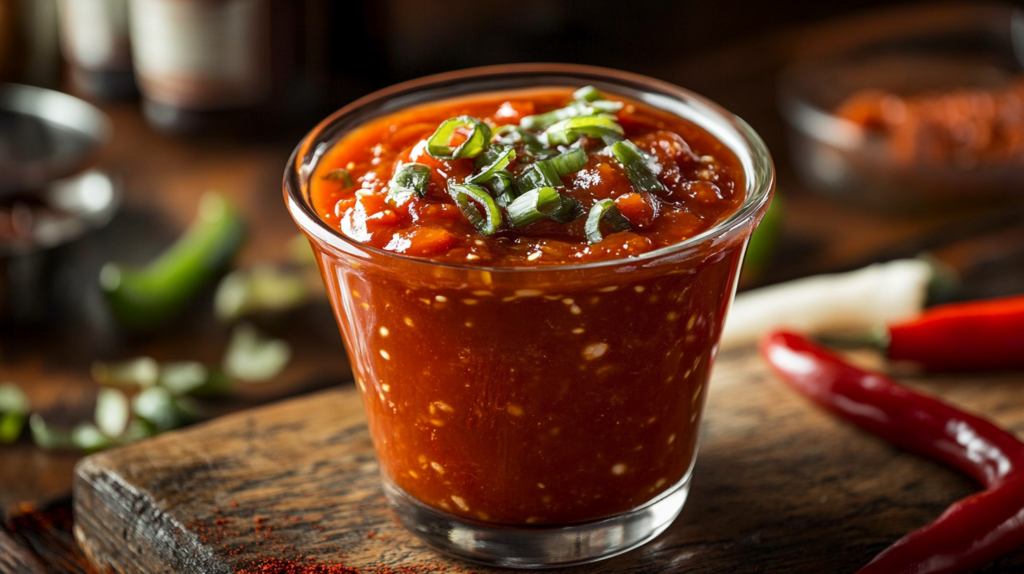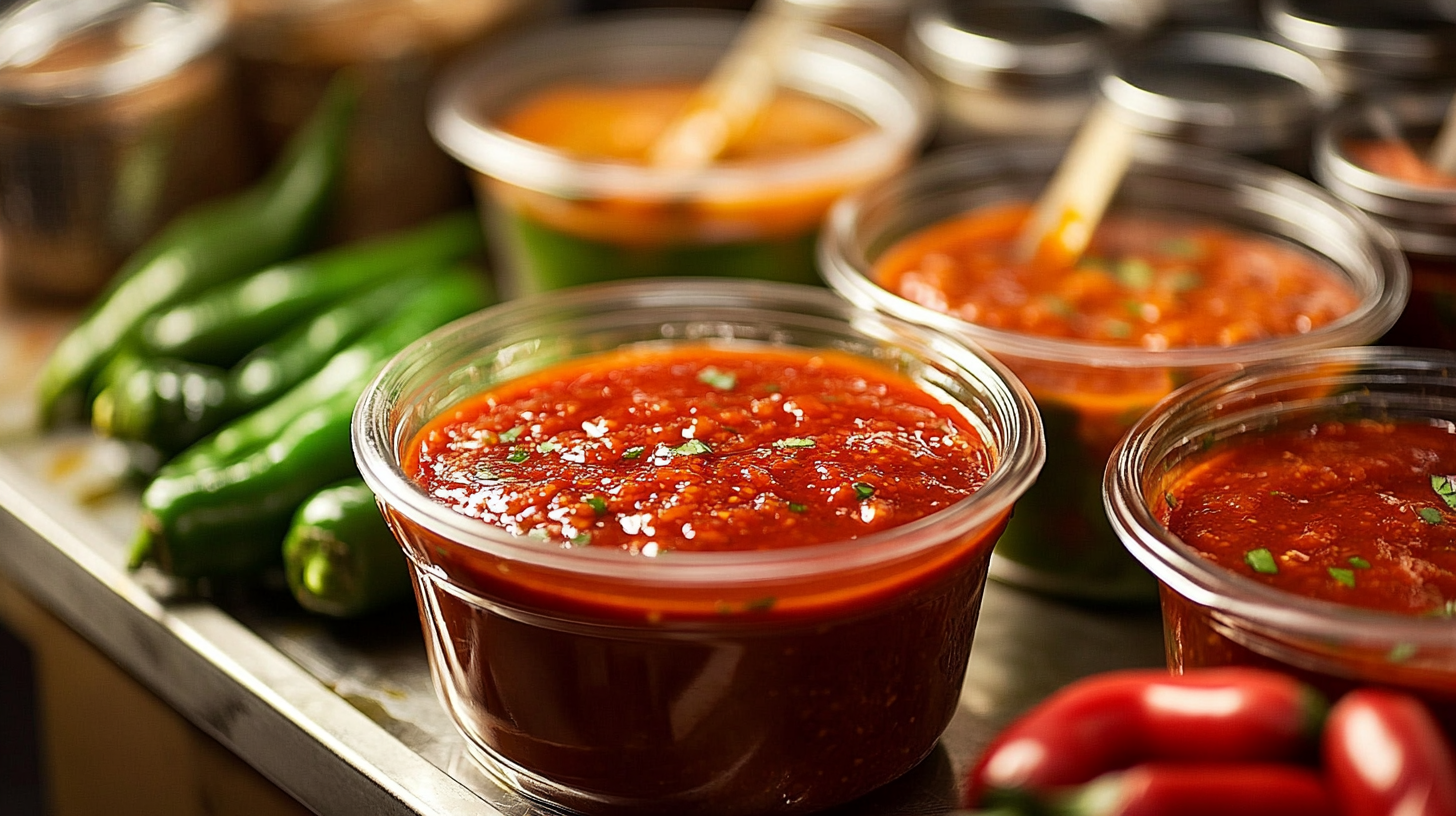Sriracha, a vibrant, spicy, and slightly sweet sauce, has captured the hearts and taste buds of people around the globe. From its origins in Thailand to its place in kitchens worldwide, Sriracha has become a staple for anyone craving a bit of heat in their meals. In this guide, we’ll dive deep into everything Sriracha: its fascinating history, ingredients, variations, creative culinary uses, health benefits, and even its place in pop culture. Let’s explore the essence of Sriracha, what makes it so irresistible, and how you can make the most of it in your own kitchen.
The Origins and History of Sriracha
The Creation of Sriracha in Thailand
Sriracha’s story begins in Thailand, where a woman named Thanom Chakkapak created the original recipe in the coastal town of Si Racha. Her blend of chili, vinegar, garlic, and sugar became popular locally before spreading to other regions. Unlike today’s widely known version, the original Thai Sriracha was milder, highlighting a balanced blend of sweet and spicy flavors.
The Journey of Sriracha to Global Recognition
While Sriracha gained local fame in Thailand, its leap to international popularity started in the 1980s when David Tran, a Vietnamese immigrant, began producing his own version in California under Huy Fong Foods. His adaptation, slightly thicker and spicier, became iconic and has since grown into a global phenomenon, loved for its bold flavors and versatility.
Ingredients and Flavor Profile of Sriracha
The Key Ingredients that Define Sriracha
At its core, Sriracha’s distinct flavor comes from a handful of simple ingredients:
- Chili Peppers: Provide the heat and vibrant red color.
- Vinegar: Adds a tangy bite and preserves the sauce.
- Garlic: Lends a savory, aromatic depth.
- Sugar: Balances the heat with a hint of sweetness.
- Salt: Enhances the overall flavor and aids in preservation.
Each ingredient plays a role in creating the balanced, complex taste that Sriracha fans know and love.
Understanding Sriracha’s Flavor Profile
What makes Sriracha unique is its harmonious blend of heat, tanginess, and sweetness. The initial hit of spice is balanced by the vinegar’s acidity, while the garlic adds depth and the sugar smooths out the overall taste, creating a sauce that enhances rather than overpowers.
Different Types of Sriracha and Their Unique Flavors
Huy Fong Sriracha vs. Traditional Thai Sriracha
When we think of Sriracha, we often imagine the classic green-capped bottle from Huy Fong Foods. However, traditional Thai Sriracha differs significantly. While Huy Fong’s version is thicker and spicier, Thai Sriracha is typically thinner and more balanced between sweet and spicy. Each brings a unique experience to the table, with Huy Fong’s offering a bolder kick and Thai Sriracha leaning toward a milder profile that pairs beautifully with seafood and lighter dishes.
Regional and Brand-Specific Variations of Sriracha
As Sriracha’s popularity has grown, various regions and brands have put their own spin on the sauce. Today, you can find Sriracha with additional flavors like lemongrass, ginger, or even fruity undertones from pineapple. These variations offer diverse options for experimenting with different dishes, allowing you to choose a Sriracha that complements a variety of cuisines and flavors.
Making Your Own Homemade Sriracha
For those who love a hands-on approach, making homemade Sriracha is an excellent way to customize the heat and flavor to your liking. Start with fresh red chilies, blend them with garlic, vinegar, and a touch of sugar and salt, then let it ferment slightly to develop complexity. Adjust the amount of sugar or garlic to find your perfect balance.
How to Use Sriracha in Cooking: From Traditional to Creative Ideas
Sriracha as a Marinade or Sauce
Sriracha’s versatility makes it ideal as a base for marinades, adding depth and spice to proteins like chicken, shrimp, or tofu. Simply mix Sriracha with soy sauce, garlic, and a touch of honey or lime juice for an easy, flavorful marinade that brings a bold kick to any dish.
Adding Sriracha to Soups, Stews, and Stir-Fries
A dash of Sriracha can elevate soups and stews, especially in brothy or creamy bases, like ramen, pho, or even tomato soup. In stir-fries, Sriracha enhances the flavor profile, adding an addictive kick that complements vegetables, meats, and noodles without overpowering other seasonings.
Unique Uses for Sriracha: Condiments, Dressings, and Even Cocktails
Sriracha’s culinary potential goes beyond traditional uses. Try mixing it into mayonnaise for a spicy aioli, or add a few drops to salad dressings for a spicy twist. In cocktails, a splash of Sriracha can provide a fiery note to classics like Bloody Marys, bringing an unexpected edge to your favorite drinks.
Health Benefits and Considerations
The Nutritional Profile of Sriracha
Sriracha is low in calories and contains minimal sugars, making it a relatively healthy condiment option. Chili peppers, the primary ingredient, are packed with antioxidants and vitamins such as Vitamin C, which can help boost immunity and promote skin health.
Health Benefits from Ingredients Like Chili Peppers and Garlic
Chili peppers contain capsaicin, a compound known for its anti-inflammatory and metabolism-boosting properties. Garlic, another key ingredient, is rich in antioxidants and can help support heart health. Together, these ingredients make Sriracha a flavorful and beneficial addition to meals in moderation.
Considerations: Moderation and Potential Drawbacks
Despite its benefits, Sriracha should be consumed in moderation. The sauce contains sodium and vinegar, which may irritate the stomach lining if consumed in large quantities. Individuals with digestive sensitivities should be mindful, as the acidity and spice can sometimes trigger discomfort.
Sriracha in Popular Culture

How Sriracha Became a Cultural Phenomenon
From apparel to memes, Sriracha’s popularity has transcended the kitchen. Known for its iconic rooster logo and green cap, Huy Fong’s Sriracha has become a symbol of culinary creativity and spice lovers’ enthusiasm. Its presence in pop culture shows no sign of slowing down, with a dedicated fan base that spans across generations and cultures.
Sriracha Festivals and Celebrations
Sriracha’s influence is celebrated through events like Sriracha festivals, where fans come together to enjoy Sriracha-inspired foods, games, and merchandise. These gatherings not only celebrate the sauce itself but also highlight its cultural impact and the creativity it inspires in food and beyond.
Exploring Sriracha Alternatives and Homemade Versions
Popular Alternatives to Sriracha
While Sriracha is beloved, there are other spicy condiments that offer unique flavor profiles. Explore sauces like Sambal Oelek, which has a chunkier texture and a purer chili taste, or Gochujang, a Korean fermented chili paste that brings a hint of sweetness and depth to dishes. These alternatives can offer different heat levels and add variety to your meals.
Crafting Custom Sriracha Blends
For enthusiasts who want to experiment, creating custom Sriracha blends can be a fun way to adjust flavors to your preference. Try using different types of chili peppers, such as habaneros for extra heat or Fresno peppers for a milder kick. Adding ingredients like lemongrass, ginger, or lime can bring additional layers of flavor, allowing for a personalized Sriracha experience.
Tips for Storing and Aging Homemade Sriracha
Proper storage is key to preserving homemade Sriracha’s freshness and flavor. After blending and cooking, allow the sauce to ferment slightly to develop complexity, then store it in an airtight container in the fridge. Over time, the flavors will mature, resulting in a deeper, richer taste. This section provides tips on maximizing shelf life and ensuring the best quality for your homemade sauce.
This part would offer readers more information on Sriracha alternatives and homemade options, enhancing the article’s appeal for food enthusiasts and DIY fans alike. Let me know if you’d like further expansion!
Frequently Asked Questions about Sriracha
What Makes Sriracha Different from Other Hot Sauces?
Unlike other hot sauces, Sriracha combines sweetness, spice, and acidity in a way that creates a well-rounded flavor. Its slightly thicker texture makes it versatile for dipping, spreading, or mixing, and its ingredient profile focuses on a balance that enhances food without overwhelming it.
How Long Does Sriracha Last?
Unopened, Sriracha can last up to two years. Once opened, it’s best stored in a cool, dry place and can last up to six months. Although refrigeration isn’t necessary, it may help maintain the sauce’s flavor and color over time.
Can Sriracha Be Used in Baking?
While unconventional, Sriracha can add a unique twist to baked goods, especially in savory recipes like spicy breads or muffins. Mixing it with honey or caramel creates a sweet-spicy glaze for treats like popcorn or roasted nuts.
Is Sriracha Vegan?
Yes, Sriracha is vegan-friendly, as it contains no animal products. The core ingredients—chili peppers, vinegar, garlic, sugar, and salt—are plant-based, making it a suitable condiment for vegan and vegetarian diets.
Conclusion: Embracing the Versatility of Sriracha
Sriracha’s unique balance of heat, sweetness, and tang has earned it a well-deserved place in kitchens worldwide. Whether you’re drizzling it on noodles, blending it into sauces, or trying it in unexpected ways, Sriracha’s bold flavor can transform dishes and inspire culinary creativity. With its roots in Thai cuisine and a journey that spans the globe, Sriracha is more than just a condiment—it’s a testament to the power of flavor and the universal appeal of spice. Embrace Sriracha’s versatility and discover how this iconic sauce can elevate your cooking to new, flavorful heights.

